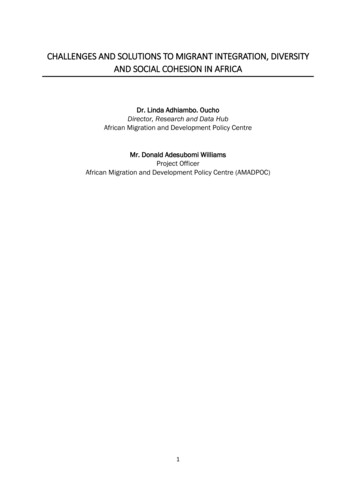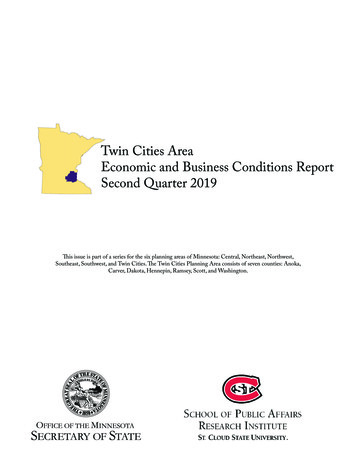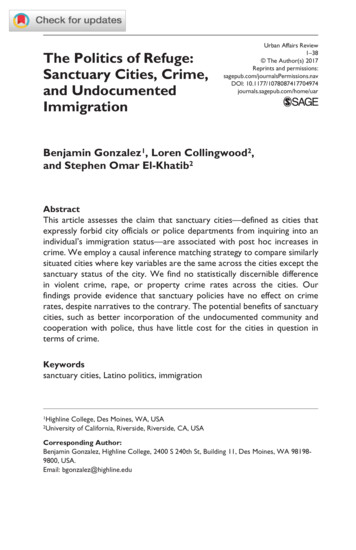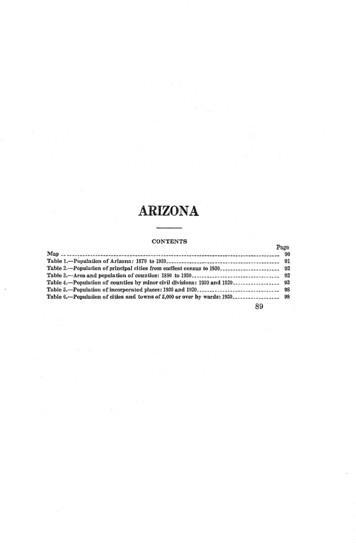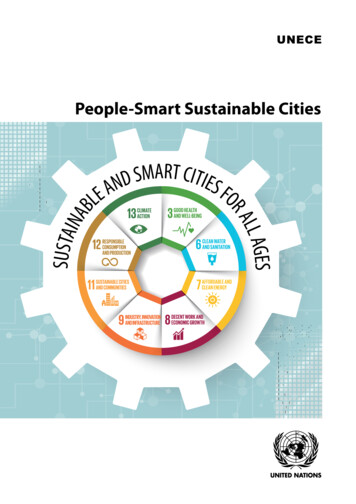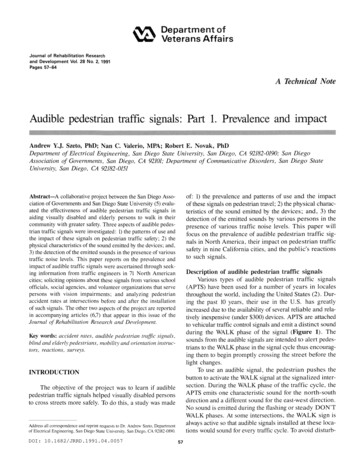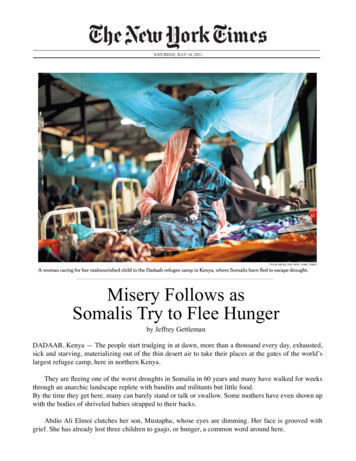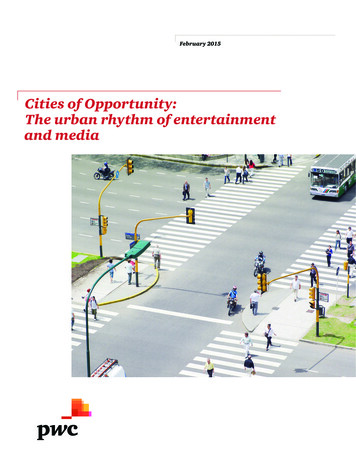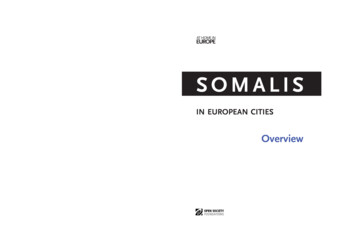
Transcription
Somalis-cover-overview-20150714 Layout 1 2015.07.14. 17:09 Page 1AT HOME INEUROPEAt Home in Europe, part of the Open Society Initiative for Europe, Open SocietyFoundations, is a research and advocacy initiative which works to advance equalityand social justice for minority and marginalised groups excluded from themainstream of civil, political, economic, and, cultural life in Western Europe.Muslims in EU Cities was the project’s first comparative research series whichexamined the position of Muslims in 11 cities in the European Union. Somalis inEuropean cities follows from the findings emerging from the Muslims in EU Citiesreports and offers the experiences and challenges faced by Somalis across sevencities in Europe. The research aims to capture the everyday, lived experiences as wellas the type and degree of engagement policymakers have initiated with their Somaliand minority constituents.SOMALIS IN EUROPEAN CITIES – OVERVIEWMinority communities – whether Muslim, migrant or Roma – continue to come underintense scrutiny in Europe today. This complex situation presents Europe with one itsgreatest challenges: how to ensure equal rights in an environment of rapidlyexpanding diversity.SOMALISIN EUROPEAN CITIESOverview
00somalis-OVERVIEW-publish-20150714 publish.qxd 2015.07.14. 17:12 Page 1Somalis in European CitiesAt Home in Europe
00somalis-OVERVIEW-publish-20150716 publish.qxd 2015.07.16. 12:41 Page 2 2015 Open Society FoundationsThis publication is available as a pdf on the Open Society Foundations website undera Creative Commons license that allows copying and distributing the publication,only in its entirety, as long as it is attributed to the Open Society Foundationsand used for noncommercial educational or public policy purposes.Photographs may not be used separately from the publication.ISBN: 978-1-940983-4-93Published byOPEN SOCIETY FOUNDATIONS224 West 57th StreetNew York NY10019United StatesFor more information contact:AT HOME IN EUROPEOPEN SOCIETY INITIATIVE FOR EUROPEMillbank Tower, 21-24 Millbank,London, SW1P 4QP,UKLayout by Q.E.D. Publishing
Open Society Foundations Mission StatementThe Open Society Foundations work to build vibrant and tolerant societies whosegovernments are accountable to their citizens. Working with local communities inmore than 100 countries, the Open Society Foundations support justice and humanrights, freedom of expression, and access to public health and education.
ACKNOWLEDGEMENTSA CKNOWLEDGEMENTSThis report is the accumulative effort of many people who have been part of theSomalis in European Cities report series. It brings together the findings from seven citiesin western and northern Europe, and within them, specific neighbourhoods:Amsterdam, Copenhagen, Helsinki, Leicester, London, Malmö, and Oslo.Somalis in European Cities has been designed and prepared by At Home in Europe, partof the Open Society Initiative for Europe, Open Society Foundations. The researchand analysis was conducted by local/national based experts from each of the countries.We are immensely grateful to Tufyal Choudhury, Lecturer in Law at DurhamUniversity and author of this report, for his thoughtful analysis of the seven studies.Moreover, the whole series is indebted to the following that formed the team ofresearchers in the seven cities:AmsterdamDr. Gery Nijenhuis, International Development Studies, Department of HumanGeography and Planning, Utrecht UniversityDr. Ilse van Liempt, Assistant Professor, Urban Geography Department, UtrechtUniversityCopenhagenHelle Stenum, PhD, Institute for Culture and Identity, Roskilde UniversityHelsinkiDr. Marja Tiilikainen, Academy Research Fellow, University of Helsinki andHonorary Visiting Fellow, City University, LondonAbdirashid Ismail, Department of Social Research, University of HelsinkiLeicesterDilwar Hussain, Founding Chair of New Horizons in British Islam, SeniorProgramme Advisor to the Institute of Strategic Dialogue, and Research Fellow at theLokahi FoundationJawaahir Dahir, Founder and Managing Director of Somali Development Services,Leciester LtdLondonDr. Anya Ahmed, Senior Lecturer in Social Policy, School of Midwifery, Nursing,Social Work and Social Sciences, University of Salford, ManchesterAsha Abdillahi, Project Officer, Account 3, LondonAT HOME IN EUROPE5
SOMALIS IN EUROPEAN CITIES– OVERVIEWMalmöProfessor Benny Carlson, School of Economics and Management, Department ofEconomic History, Lund UniversityOsloCindy Horst, Research Director, Research Professor, Refugee and Migration Studies,Peace Research Institute Oslo (PRIO), OsloOur deepest appreciation is offered to all the local residents from the neighbourhoodsin the cities who took part in the focus groups and without whom this research wouldnot have been possible. Thanks are also extended to various city officials, communityactivists, members of various grass roots and civil society organisations, and relevantexperts.At Home in Europe has final responsibility for the content of the report, including anyerrors or misrepresentations.Open Society Initiative for Europe Team (At Home in Europe)Nazia HussainDirectorAna MacouzetProgram CoordinatorHélène IrvingProgram CoordinatorAndrea Gurubi WattersonProgram OfficerKlaus Dik NielsenAdvocacy OfficerCsilla TóthProgram AssistantTufyal ChoudhurySen. Policy ConsultantSzilvia SzekeresFinance Coordinator6OPEN SOCIETY FOUNDATIONS2015
PREFACEP REFACEA central belief of the Open Society Foundations is that all people in an open societycount equally and should enjoy equal opportunities. The Open Society Foundationswork day-to-day with civil society organizations across Europe to respond todiscrimination, prejudice and injustice; to understand the emergence of new andsometimes worrying political phenomena; to inform better practices in policing andsecurity; to connect those seeking justice and equality with policymakers andinstitutions; to promote inclusion for Europe’s minorities; to support a critical andinformed discourse among nongovernmental actors; and to empower grassrootsorganizations to seek change for themselves, unique to their own local context.At Home in Europe, part of the Open Society Initiative for Europe, Open SocietyFoundations, is a research and advocacy initiative which works to advance equality andsocial justice for groups excluded from the mainstream of civil, political, economic,and, cultural life in Western Europe. It places a high priority on local community andcity level practices that mitigate discrimination and seek to ensure access to equalopportunities for all. At Home in Europe engages with policymakers, civil societyorganisations, and communities at the local, national and international level toimprove the social inclusion of Europe’s diverse minority and marginalisedcommunities in different ways.Minority communities – whether Muslim, migrant or Roma – continue to come underintense scrutiny in Europe today. This complex situation presents Europe with one itsgreatest challenges: how to ensure equal rights in an environment of rapidly expandingdiversity. The Somali community is one such emerging minority group on whom alack of precise data hampers the possibility of achieving meaningful integration.People of Somali origin have lived in parts of Europe for many generations but in thepast 15 years their numbers have increased. There are no accurate figures for thenumber of Somalis in Europe but on the whole, whilst small in absolute numbers, theyare among one of the continent’s largest refugee groups and a growing minoritypopulation. Europe’s Somalis can be divided into three broad categories: people ofSomali origin born in Europe, Somali refugees and asylum seekers (who came directlyfrom Somalia or neighbouring countries largely as a result of conflict) and Somalis whomigrated to a country in Europe from elsewhere in Europe, such as from Sweden to theUK for example. They are a diverse and vibrant community who suffer from negativeand biased media representation and stereotyping. There is a limited understanding onthe specific needs of this community and they are in the category of groups thatexperience significant inequalities in accessing education, employment, health, andhousing with resulting poor outcomes. Somali community groups are very present incertain countries in Europe but their engagement with policymakers and in local andnational bodies can be relatively limited.AT HOME IN EUROPE7
SOMALIS IN EUROPEAN CITIES– OVERVIEWThe comparative research series ‘Somalis in European Cities’ examines city andmunicipal policies that have actively sought to understand Somali origin communitiesand their specific needs. The research aims to capture the everyday, lived experiences aswell as the type and degree of engagement policymakers have initiated with theirSomali and minority constituents. An underlying theme is how Somali communitieshave themselves actively participated in tackling discrimination and whether the needsof specific groups warrant individual policy approaches in overcoming barriers to equalopportunities.The ‘Somalis in European Cities’ series contains seven individual city reports and anoverview. The cities selected take into account the population size, diversity, and thelocal political context. They are: Amsterdam, Copenhagen, Helsinki, Leicester,London, Malmö, and Oslo. All seven city reports were prepared by teams of localexperts on the basis of the same methodology to allow for comparative analysis. Eachreport includes detailed recommendations for improving the opportunities for fullparticipation and inclusion of Somalis in wider society in the selected city. Theserecommendations will form the basis for At Home in Europe of the Open SocietyInitiative for Europe’s advocacy activities.8OPEN SOCIETY FOUNDATIONS2015
Somalis in European CitiesOverview
SOMALIS IN EUROPEAN CITIES– OVERVIEWTable of Contents1. Introduction .2. Identity and Belonging .2.1 Somali Identity .2.2 European National Identity .2.3 Local and City Identity .2.4 Contextual Nature of Identity .2.5 Religion and Identity .2.6 Clan Affiliation .2.7 Discrimination .2.8 Gender and Identity .2.9 Key Findings .3. Education .3.1 Qualifications and Experience of Schools .3.2 Understanding the Educational System .3.3 Teachers’ Expectations and Pupils’ Aspirations .3.4 Language .3.5 Pupil Mobility .3.6 Key Findings .4. Employment .4.1 Low Employment Rates, in Low-paid,Low-status Jobs .4.2 Challenges in Finding Employment:Language Proficiency .4.3 Challenges in Finding Employment:Knowledge about the Labour Market .4.4 Challenges in Finding Employment:Discrimination .4.5 Support for Finding Jobs .4.6 The Impact of Unemployment .4.7 Key Findings .5. Housing .5.1 Housing and Refugee Resettlement .5.2 Home Ownership and Renting .5.3 Meeting the Costs of Renting and Buying 4454648484949OPEN SOCIETY FOUNDATIONS2015
SOMALIS IN EUROPEAN CITIES6.7.8.9.10.Annex 1.– OVERVIEW5.4 Understanding the Housing System .5.5 Discrimination .5.6 Overcrowding .5.7 Segregation .5.8 Homelessness .5.9 Key Findings .Health Care .6.1 Levels of Health .6.2 Mental Health .6.3 Use of and Access to Health Care .6.4 Female Genital Mutilation .6.5 Children’s Services and Support for Families .6.6 Khat .6.7 Key Findings .Policing and Security .7.1 Perceptions of Crime and Security .7.2 Perceptions of Policing .7.3 Stop and Search .7.4 Counter-terrorism and Radicalisation .7.5 Key Findings .Civil and Political Participation .8.1 Access to Citizenship .8.2 Political Participation .8.3 Influencing Change .8.4 Civic Participation .8.5 The Role and Development of Somali CivilSociety Groups .8.6 Key Findings .The Media .9.1 Negative Media Coverage .9.2 Experiences of Engagement with the Media .9.3 Somali Participation in the Media .9.4 Key Findings .Conclusions .Bibliography .AT HOME IN 72737475767878818182848611
SOMALIS IN EUROPEAN CITIES– OVERVIEWIndex of TablesTable 1. Labour market participation rate for Somali immigrants (%) . 40Index of BoxesBox 1. Good Practice in Oslo: Somali Student Association .Box 2. Good Practice in Leicester: Taylor Road Primary School .Box 3. Good Practice in London: Tower Hamlets STEP Project .Box 4. Good Practice in Amsterdam: Somali Women's Foundation .Box 5. Good Practice in London: Tower Hamlets Homes .Box 6. Good Practice in Oslo: the Housing Project in Groenland .Box 7. Good Practice in Copenhagen: Health Communicators .Box 8. Good Practice in Oslo: Equal Health Services Project .Box 9. Good Practice Malmo: Civil Society Training .Box 10. Good Practice in Copenhagen: CODKA .Box 11. Good Practice in Oslo: The Norwegian BroadcastingCorporation's Trainee Project .12OPEN SOCIETY FOUNDATIONS37384747545564647783832015
INTRODUCTION1.I NTRODUCTIONThis report forms the overview of the Open Society Foundations’ At Home in Europeproject on Somalis in European cities. At Home in Europe is a research and advocacyinitiative that works to advance the social inclusion of vulnerable communities in achanging Europe. The project explores the political, social, economic and culturalparticipation of marginalised majority and minority communities in western Europe. Itplaces a high priority on local community and city authority measures that mitigatediscrimination and seek to ensure equal treatment for all. The project’s underlyingtheme is to identify the barriers to full and equal treatment, better understand thefactors leading to marginalisation, identify and promote effective integration policiesand practices in Europe, and undertake research-based advocacy in order to improveparticipation and opportunities through engagement with residents, civil society andpolicymakers.The Somalis in European cities project builds upon and develops the work of earlierOSF research on Muslims in EU cities. The need for research that provides a greaterunderstanding of experiences of Somali communities first emerged during discussionswith policymakers and practitioners in the course of completing the research andengaging in advocacy for the Muslims in EU cities reports. National and city officialsin a number of cities where OSF was engaged noted that, compared with the olderminority communities that had arrived in the postwar period as economic migrants,Somalis formed a new rapidly growing community that was little understood bypolicymakers. Initial indications suggested that they were communities that were at riskof social exclusion and for which there was a need for solid research evidence tosupport the development of effective inclusion and integration policies.The studies cover the experience of Somalis in seven cities in six western and northernEuropean countries: Amsterdam (the Netherlands), Copenhagen (Denmark), Helsinki(Finland), Leicester (UK), London (UK), Malmö (Sweden) and Oslo (Norway). Basedon available statistics, 37,432 Somalis are estimated to live in the Netherlands, 57,873in Sweden, 19,707 in Denmark, 36,651 in Norway and 16, 721 in Finland.1 In the1These numbers are based on the latest statistics available from the respective national statisticalagencies on residents born in Somalia or born of Somali-born parents. The statistics can be foundat the following sites: Netherlands (2014), at http://statline.cbs.nl/StatWeb/publication/?DM SLEN&PA 37325eng&D1 a&D2 a&D3 0&D4 0&D5 192&D6 a&LA EN&HDR T&STB G2,G1,G3,G5,G4&VW T (accessed 9 June 2015); Sweden (2012), e0101 Fodelseland och ursprungsland.xls(accessed 16 June 2015); Denmark (2015), athttp://www.statbank.dk/statbank5a/default.asp?w 1366 (accessed 16 June 2015); Norway(2014), at ef/aar/2014-04-24?fane tabell&sort nummer&tabell 193678 (accessed 16 June 2015); Finland (2014), at http://193.166.171.75/Dialog/varval.asp?ma 030 vaerak tau 102 en&ti Language according to age and sex by region 1990 - 2013&path ./Database/StatFin/vrm/vaerak/&lang 1&multilang en (accessed16 June 2015).AT HOME IN EUROPE13
SOMALIS IN EUROPEAN CITIES– OVERVIEWUK, the 2011 census recorded just over 101,000 people living in the UK who hadbeen born in Somalia; however, given the longer migration history and the presence ofa significant second and third generation of British-born Somalis, the total BritishSomali population is likely to be significantly higher.Somalis across five of the cities share a common experience through their arrival over asimilar period of time as refugees rather than economic migrants. Somalis arrived inmost of the cities in this study in two main cohorts. The first group began to arrive insignificant numbers in the late 1980s and early 1990s, as refugees fleeing from politicalpersecution and the ensuing civil conflict in Somalia. Many of those who arrived inthis first group were educated, and some were professionals with experience of livingand working in urban cities. A second period was in the mid-2000s, when significantnumbers of refugees arrived in Europe from Somalia, due in part to the increase inconflict following the rise of the al-Shabaab movement. This second group of Somaliarrivals had experienced the trauma of living through a decade-long civil war; manywere from rural areas and were less likely, compared with the earlier group, to haveformal education or training.The experience of Somalis in the UK is different. Since the British colonisation ofSomaliland (northwest Somalia) in 1897 there has been an almost continuous patternof migration. Somali seafarers settled in port areas of east London, Cardiff andLiverpool. Somali migration is therefore an integral part of the UK’s 20th-centurypostwar immigration history, particularly before the 1962 Immigration Act. In the1960s many sailors travelled to industrial cities – Sheffield, Birmingham andManchester and London – for work, while Somali women started to migrate andstudents also settled as citizens. Thus, while many Somalis did arrive in the UK fromthe late 1980s onwards as refugees, they were often settling in cities with a longerestablished Somali community. A further distinct feature of Somali communities in theUK is the significant number that arrived after 1999 from other European countries.These were Somalis who had initially arrived in other European countries, like theNetherlands or Denmark, in the late 1980s and early 1990s and received refugee statusand then citizenship of these countries. However, having secured EU citizenship, theythen moved to the UK as EU migrants. This is a key feature of the Somali populationin the Leicester report.There are large populations of Somalis, often concentrated in particularneighbourhoods in each of the cities studied.In Amsterdam, the official statistics on Somalis counted 1,286 Somalis, mostly livingin the city districts of Nieuw West (287), West (244), Zuid Oost (238) and Noord(205) in 2013.The Danish-Somali population in Copenhagen was also concentrated in fourneighbourhoods, Nørrebro, Brønshøj, Husum and Bispebjerg which combined to hostover 61 percent of the total population of 4,742 Danish-Somalis in the city in 2011.14OPEN SOCIETY FOUNDATIONS2015
INTRODUCTIONThe population of Somali-speakers in Helsinki in 2012 was 6,843, approximately halfof the total Somali population in Finland.The total number of Somalis in Leicester was estimated to be between 10,000 and15,000 in 2011, nearly 70 percent of which live in the four wards of Spinney Hills,Stoneygate, Beaumont Leys and Charnwood. The London boroughs of Camden andTower Hamlets were chosen as the research focus, based on the nature and size of theBritish-Somali population in each borough: there were close to 3,000 Somali-bornBritish-Somalis in each borough, according to the 2011 census, although someestimates put the number of people of Somali origin in Tower Hamlets at closer to10,000 people.In 2011, there were 1,551 Somali-born individuals in Malmö, of which 77 percentlived in the three city districts with the highest number of foreign-born inhabitants:Rosengård (622), Södra Innerstaden (315) and Fosie (263).In 2012, there were 12,779 Norwegian-Somalis in Oslo, making up the third-largestimmigrant group in the city. Norwegian-Somalis are mainly concentrated in the centreand east of the city.The common migration and settlement histories of Somalis in most of these citiesprovide an opportunity for assessing the impact of different policies on integration andinclusion.While the individual city reports (published alongside this Overview Report) focus onthe experiences of Somali communities living in each city, this report provides anopportunity to consider the commonalities and differences across the cities and theextent to which these are shaped by the divergences in the policy approach adopted bythe individual city authorities. Chapter 2 begins with an exploration of the issues ofidentity and belonging. Chapters 3–8 explore experiences in the key domains of socialinclusion and integration: education, employment, housing, health and socialprotection, policing and security, and civil and political participation. Chapter 9examines the role of the media on integration and inclusion. Chapter 10 provides sometentative conclusions that emerge from the findings.AT HOME IN EUROPE15
SOMALIS IN EUROPEAN CITIES2.I DENTITYAND– OVERVIEWB ELONGINGThis chapter explores the findings relating to issues of identity and belonging amongSomalis in Europe. How individuals identify themselves and the way in which they areidentified are important for integration. A person may be employed, or succeed ineducation, but may not feel a sense of belonging to the place where he or she lives.Furthermore, as noted in the previous chapter – with the exception of the participantsin the London research – a majority of Somalis in the other cities arrived in Europeafter the late 1980s as refugees or are the children of such refugees. Group belongingand identity has already played a role in their presence in Europe as people who aregranted refugee status, having satisfied officials that they fled their country owing to a“well-founded fear of being persecuted for reasons of race, religion, nationality,membership of a particular social group or political opinion”.2The approach and design of the At Home in Europe research project, with its focus onSomalis, is underpinned by an assumption that ethnicity (in this case being Somali) isan important marker of identity that has an impact on the processes of inclusion andintegration. While this is a common starting point for the research, the discussion inthe individual city reports highlights the diversity of experiences within this groupalong lines of gender, age, migration history and generation. The research exploredparticipants’ concepts and ideas of a range of different identities (ethnic, national andreligious) and how their experiences shaped their sense of belonging in relation to each.It also examined their sense of belonging to the neighbourhoods and cities they livedin, as well as the country, noting aspects of everyday experience that affected their senseof belonging.Self-perception and description are important, but this does not mean individuals areentirely free to determine their identity; in fact the perception of others is also crucial.Young Somalis born in Europe face challenges from how others perceive them innegotiating both their European and Somali identities. The chapter begins byexamining how participants viewed their Somali identity before looking at their senseof having a European national (that is, British, Dutch, Danish, Finnish, Norwegian orSwedish) identity.216UN Convention Relating to the Status of Refugees 1951 article 1 defines a refugee as a personwho ‘owing to well-founded fear of being persecuted for reasons of race, religion, nationality,membership of a particular social group or political opinion, is outside the country of hisnationality and is unable or, owing to such fear, is unwilling to avail himself of the protection ofthat country; or who, not having a nationality and being outside the country of his formerhabitual residence as a result of such events, is unable or, owing to such fear, is unwilling toreturn to it’.OPEN SOCIETY FOUNDATIONS2015
IDENTITY AND BELONGING2.1Somali IdentityAll participants viewed their Somali identity as an important aspect of their identity.However, across all cities, experiences of Somali identity and belonging differedbetween those born in Europe or who arrived as young children and those born inSomalia and who arrived in Europe as young adults. The strength of emotional andpersonal ties for first-generation migrants to their country of origin is common amongmigrant groups and may perhaps be stronger among refugees who left their countrydue to fear of persecution rather than through a positive choice of planned migration.In many cases, individuals, sustained by memories of childhood and formative years,continued close ties with family in Somalia, combined with experiencing the challengesof adjusting to a new cultural and social environment, and retained a desire to return toSomalia.My heart is not here. It is in Somalia. We are to raise our children here but Ibelong to Somalia and I am concerned about the country’s wellbeing so myfuture is there and being part of its rebuilding. My heart, mind and soul areinvested in Somalia. (Leicester)By contrast, those who arrived as young children often had a stronger sense ofattachment to the country they were growing up in:I came to this country when I was little, whatever I know, I have learned in thiscountry. When I think of what I have learned and if I could apply it in anothercountry, it feels very difficult. I feel like I can’t apply it anywhere else if I don’tmake an extra effort. So I don’t think I am going anywhere else any time soon.(Helsinki)Most participants considered it important to retain and develop a Somali identity.Many valued living in larger cities with a significant Somali community, as thisprovided the space and opportunities for maintaining and developing their Somaliidentity. Across the cities, fluency in the Somali language was viewed as a keyprerequisite for retaining and supporting Somali identity. The Oslo report suggeststhat the teaching of the mother-tongue language can play an important part in astudent’s identity and self-esteem. Such classes can be a way of support
Somali origin born in Europe, Somali refugees and asylum seekers (who came directly from Somalia or neighbouring countries largely as a result of conflict) and Somalis who migrated to a country in Europe from elsewhere in Europe, such as from Sweden to the UK for example. They are a diverse and vibrant community who suffer from negative
